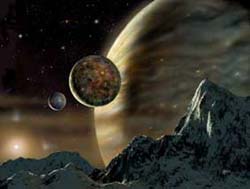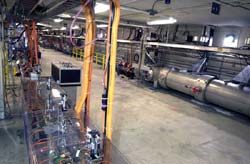This area deals with the fundamental laws and building blocks of nature and how they interact, the properties and the behavior of matter, and research into space and time and their structures.
innovations-report provides in-depth reports and articles on subjects such as astrophysics, laser technologies, nuclear, quantum, particle and solid-state physics, nanotechnologies, planetary research and findings (Mars, Venus) and developments related to the Hubble Telescope.

Energy emissions far greater than predicted by Planck’s Law
You can’t get something for nothing, physicists say, but sometimes a radical innovation can come close.
Researchers at Sandia National Laboratories — exceeding the predictions of a 100-year-old law of physics — have shown that filaments fabricated of tungsten lattices emit remarkably more energy than solid tungsten filaments in certain bands of near-infrared wavelengths when heated.
This greater use

New class of superweak particles may reveal secrets of hidden mass in universe
A UC Irvine study has revealed a new class of cosmic particles that may shed light on the composition of dark matter in the universe.
These particles, called superweakly interacting massive particles, or superWIMPs, may constitute the invisible matter that makes up as much as one-quarter of the universe’s mass.
UCI physicists Jonathan Feng, Arvind Rajaraman and Fumihiro Takayama report th

NASA launched its second Mars Exploration Rover, Opportunity, late Monday night aboard a Delta II launch vehicle whose bright glare briefly illuminated Florida Space Coast beaches.
Opportunity’s dash to Mars began with liftoff at 11:18:15 p.m. Eastern Daylight Time (8:18:15 p.m. Pacific Daylight Time) from Cape Canaveral Air Force Station, Fla.
The spacecraft separated successfully from the Delta’s third stage 83 minutes later, after it had been boosted out of Earth orbit

Astronomers looking for planetary systems that resemble our own solar system have found the most similar formation so far. British astronomers, working with Australian and American colleagues, have discovered a planet like Jupiter in orbit round a nearby star that is very like our own Sun. Among the hundred found so far, this system is the one most similar to our Solar System. The planet’’s orbit is like that of Jupiter in our own Solar System, especially as it is nearly circular and there

Daniel S. Carman (Ohio University) and nearly 150 members of Jefferson Lab’s CLAS Collaboration studied the spin transfer from a polarized electron beam to a produced Lambda particle. Their results were recently published in Physical Review Letters.
Measurements taken using Jefferson Lab’s CEBAF Large Acceptance Spectrometer (CLAS) are telling us more about how matter is produced from “nothing,” that is, the vacuum.
Using the CLAS in Hall B, Daniel S. Carman of Ohio Universit

Researchers at the U.S. Department of Energy’s Thomas Jefferson National Accelerator Facility have produced first light from their 10 kilowatt Free-Electron Laser (FEL). This device has been upgraded from the “one kilowatt Infrared Demonstration” FEL, which broke power records by delivering 2,100 watts of infrared light during 2001. Only one and one-half years after the one kilowatt FEL was dismantled, the newly improved FEL, designed to produce 10 kilowatts of infrared and one kilowatt of ultraviol